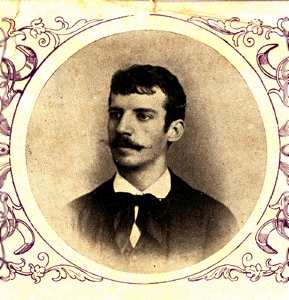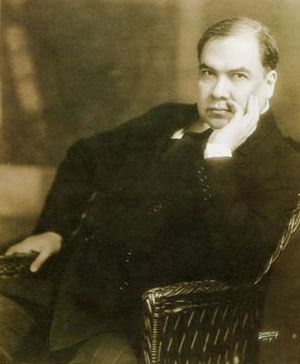Julián del Casal facts for kids
Julián del Casal (born November 7, 1863 – died October 21, 1893) was a famous poet from Havana, Cuba. He started writing when he was young. Later, he became known as a very important writer who helped start a new style called Modernismo in Latin America.
He was inspired by French poetry and also by another famous writer, Rubén Darío.
Contents
Julián del Casal's Early Life
Julián del Casal was born in Havana, Cuba. His family wasn't rich, but they lived comfortably. His mother, Maria del Carmen de la Lastra y Owens, passed away in 1868 when Julián was only four years old. His father, Julián del Casal y Ugareda, raised him. His father died in 1885 when Julián was 22.
Julián was part of a Catholic family. He was baptized when he was two months old, on December 23, at a church called La iglesia del Santo Angel Custodio.
Julián del Casal's Education
In 1870, Julián del Casal began his schooling at a formal place called El Real Colegio de Belén. He earned his bachelor's degree from there in 1880. After graduating, he decided to study law at the Havana University School of Law.
He started his law studies in 1881. However, he had to stop soon after because his family faced money problems. After leaving university, he focused on his writing career. He also started working as a finance minister.
Casal's Writing Career
When he was just 14 years old, Casal started his own newspaper. He created it with a friend from high school, Arturo Mora. They named their secret, handwritten newspaper El Estudiante, periódico clandestino y manuscrito.
After high school, he published his first work. It was in a weekly journal about science, arts, and literature. Casal's poem was called El Ensayo. It was the first poem by a poet to be published in a Cuban newspaper. In the same year, he also began working as a clerk at El Ministerio de Hacienda (The Treasury Department).
His writing career really took off in 1885. Casal began publishing his works in La Habana Elegante. This was a Cuban magazine important for the Modernist movement at that time. In 1888, he also started working with El Figaro. Later that year, he traveled to Madrid, Spain.
In 1889, Casal returned to Cuba. He began helping with meetings for the Galeria Literaria. In 1890, he published his first book, which he named Hojas al Viento. He also helped edit La Discusión. The next year, he started working with La Habana Literaria.
His second book, Nieve, came out in 1892. This was also the year he met Rubén Darío. Darío even dedicated a poem, El Clavicordio de la Abuela, to Casal. In 1893, Casal had a lot of contact with Darío. He wrote an article about Darío and sent him a letter shortly before he passed away.
Casal's Major Works
Casal only published two poetry collections during his life: Hojas al viento and Nieve. His last collection, Bustos y rimas, was not finished before he died. However, it was published in 1893, soon after his death. His friend, Enrique Hernández Miyares, helped with this. This last book was different because it included both prose (like stories) and poetry.
Hojas al viento has 49 poems. It shows Casal's early writing style. The poems in this book often talk about current events. Some were even seen as "imitations," showing how other writers influenced him. People at the time liked the book. They saw it as a promising start for a new poet.
Casal kept publishing poems in different Cuban magazines. In 1892, he put many of these poems together in his second collection, Nieve. This book is divided into five parts, with poems grouped by their topic.
- The first part, Bocetos antiguos, has poems inspired by old pagan and Christian ideas.
- The second part, Mi museo ideal, is famous. Its poems were inspired by the art of Gustave Moreau. Julián had written letters to Moreau.
- The third part, Cromos españoles, is a collection of well-known Spanish word pictures.
- The fourth part, Marfiles viejos, contains 16 sonnets. These poems show his worries and fears about life.
- The fifth and final part, La gruta del ensueño, finishes the collection with 17 other poems.
Nieve was somewhat successful with critics. However, most people in Cuba felt that Julián del Casal's themes were too dark and sad.
Casal's Later Life and Legacy
Julián del Casal continued publishing his works until he passed away in October 1893. Earlier that year, he wrote an article about his friend Rubén Darío. Darío was known as the "father of Modernism." This article appeared in the Cuban magazine La Habana Elegante. Casal also started writing his final book, Bustos y Rimas.
Before he died, Casal wrote a letter to Rubén Darío. In it, he talked about feeling like death was coming. Not long after this, Casal was at a friend's house. He had a sudden bleeding event during a conversation after dinner. He died because of this. He was buried in his family's burial place. His final book, Bustos y Rimas, was finished by his friend Enrique Hernández Miyares. It was published soon after Casal's death.
See also
 In Spanish: Julián del Casal para niños
In Spanish: Julián del Casal para niños




